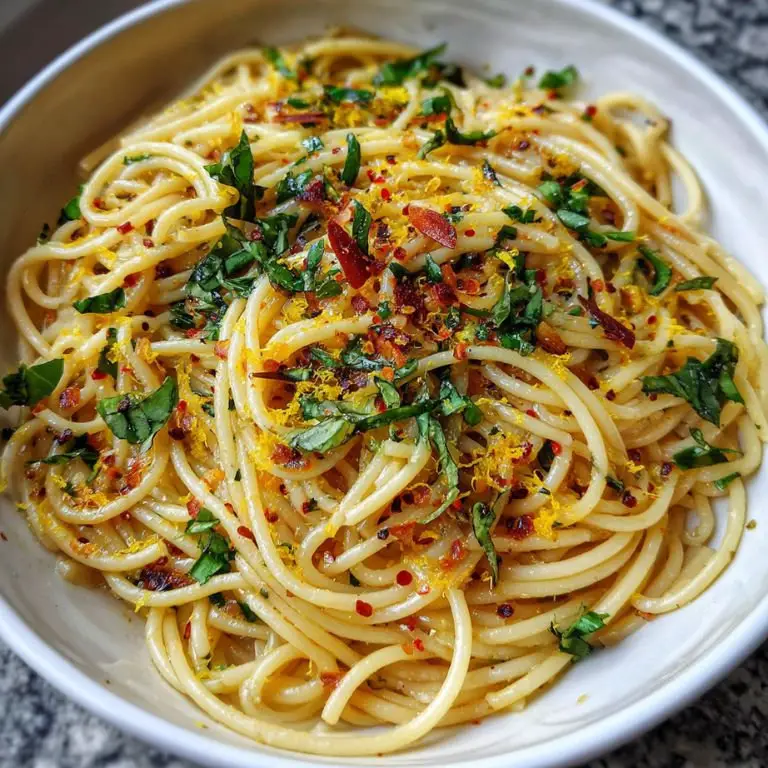Warm, cozy, and utterly satisfying, this Vegan Aglio Olio with Fresh Basil transforms the classic pasta aglio e olio recipe into a vibrant, plant-based delight. It’s simple aglio olio recipe magic—just spaghetti, olive oil, garlic, chili flakes, and fragrant basil. No dairy, no fuss, all flavor. Whether you need a quick weeknight dinner or a minimalist olive oil pasta recipe, this dish will hit the spot with its garlic-forward punch and herbal lift.
Vegan Aglio Olio with Herbaceous Basil
Prep Time 10 minutes mins
Cook Time 15 minutes mins
Total Time 25 minutes mins
Course Main Course
Cuisine Italian
Servings 4 generous plates
Large pot for boiling pasta Alternative: deep skillet with cover (great for one‑pot pasta)
Large skillet or sauté pan Alternative: wide nonstick pan works too
Slotted pasta fork or tongs
Microplane or fine grater (for lemon zest)
Cutting board and sharp chef’s knife
Mixing bowl (for finishing sauce and basil)
- 400 g dried spaghetti or any long-cut pasta
- ⅔ cup extra-virgin olive oil – this olive oil sauce for pasta forms the rich silky base
- 8 –10 fresh garlic cloves thinly sliced
- 1 tsp red pepper flakes adjust to taste for the kick in pasta aglio olio e peperoncino
- 1 cup fresh basil leaves torn gently
- ½ tsp sea salt plus more for pasta water
- Freshly ground black pepper to taste
- Zest of 1 lemon optional, for brightness
- 2 Tbsp nutritional yeast optional for subtle cheesy umami; still vegan
Boil the Pasta
Fill a large pot with water, add a tablespoon of salt, and bring to a rolling boil.
Add spaghetti and cook until just shy of al dente (usually about 9 minutes for standard spaghetti). Stir occasionally.
Reserve 1 cup of pasta cooking water before draining.
Infuse the Olive Oil
Meanwhile, in a large skillet over medium‑low, warm the olive oil.
Add thin garlic slices and gently sauté, stirring constantly. You want them to turn a light golden, not brown—about 2–3 minutes. This is key for that essential pasta with olive oil and garlic flavor.
As soon as you see light coloring, add red pepper flakes for the signature “peperoncino” element of a proper pasta aglio olio e peperoncino.
Build the Sauce
Remove the pan from heat momentarily; add a splash of reserved pasta water (2–3 Tbsp) to help emulsify the olive oil sauce for pasta.
Gently swirl so the garlic and oil combine into a cohesive, glossy sauce.
Marry Pasta & Sauce
Return the pan to low heat and add the drained spaghetti.
Toss well, using tongs, to coat every strand in the olive oil sauce for pasta. If needed, add more pasta water—this technique is essential for a classic spaghetti alio olio experience.
Season with salt and pepper to taste.
Incorporate Fresh Basil & Finishing Touches
Immediately turn off the heat and stir in torn basil leaves. The residual warmth will wilt them slightly, releasing aroma.
Add lemon zest if using, and sprinkle nutritional yeast for nutty, savory depth reminiscent of grated cheese.
Give a final toss, taste, and adjust seasoning.
Pairings
Crisp Green Salad
A fresh spring mix with shaved fennel, cucumber ribbons, and lemon-tahini dressing complements the herbal pasta’s warmth.
Crusty Bread or Garlic Bread
A sliced baguette toasted with olive oil makes a perfect mop for the garlicky sauce.
White Wine
A Sauvignon Blanc or Pinot Grigio brightens the simple aglio olio recipe with citrus and herb notes, balancing its spice.
Roasted Veggies
Add seasonal vegetables—like zucchini or cherry tomatoes—drizzled in olive oil and roasted until golden, for extra color and nutrition.
Grilled Plant-Based Protein
Think smoked tofu or vegan sausage on the side—lightly glazed and served warm—to round out the meal with protein.
FAQs
1. Can I use any pasta shape other than spaghetti?
Absolutely. Linguine, fettuccine, or long-cut bucatini all work well. The sauce clings especially nicely to spaghetti alio olio or bucatini.
2. Should I use basil as my herb, or are there alternatives?
Fresh basil gives sweet, peppery notes, but parsley, chives, or even oregano work too. Parsley keeps it classic; basil adds summer brightness.
3. My garlic burns quickly—how do I avoid that?
Lower the heat and slice garlic evenly. As soon as edges begin to golden, reduce heat or remove pan briefly—burnt garlic tastes bitter and overpowers the olio e aglio recipe.
4. Is nutritional yeast necessary?
Nope! It’s optional, added for vegan-friendly umami that mimics cheese. If you have vegan parm or miso, those also work beautifully.
5. How spicy is this pasta aglio e olio recipe?
Quite mild by default—1 tsp red pepper flakes gives a gentle heat. Add more for kick. The result is a perfect alio olio pasta recipe with a warming, flavorful touch but not scorch-you-off.
